How to conduct an offline coding camp? A guide from teacher’s first hand experience
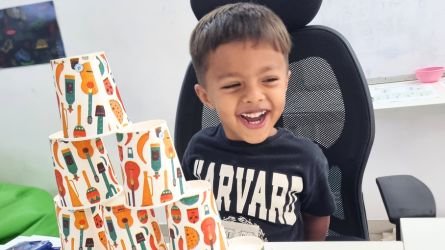
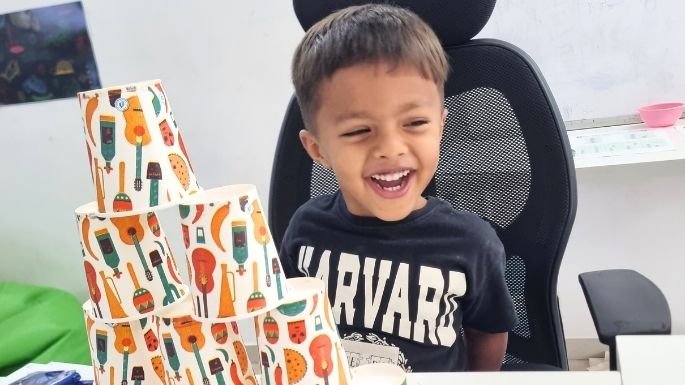
Every Sunday, kids who own havi’s DIY Robotics Starter Kit visit our space to build projects together — a space full of curiosity, excitement, and innovation.
But one Sunday was different.
Zidaan wanted to join the session with his sister Alizeh. Alizeh is 8, and Zidaan is 5. Their mother, clever and observant, understood that Zidaan is too young for the robotics club. In a bit of a dilemma, she came to us and asked- “Can you do something for the little ones too?”
It was summer vacation time, and out of our passion for teaching, we decided to do something for these younger siblings.
That’s how our Offline Coding Activity Summer Camp was born — designed especially for kids aged 5 to 7. A screen-free experience that builds logic, reasoning, and visual thinking through the fundamentals of coding — all through play.
Kids were super happy, and parents remained very supportive and positive after the program because it was time well spent for the kids. We conducted one more batch of this summer camp. We had no idea the unplugged coding activity program would be appreciated this much.
So now, after conducting two back to back summer camp batches of offline coding activities and refining the content thoroughly, we are sharing the first hand experience as a teacher and facilitator of the camp. You get the outline, the equipment, the wow moments, the toughest class, the learning levels, the materials required, and everything else. This will help you conduct an Offline Coding Workshop or launch it as a separate course for ages 5 to 7 years.
First, what is Offline Coding?
Offline coding, also known as screenless coding or unplugged coding are various offline activities that teach concepts of programming to the kids. Yes, the activities are screen-free. Read this detailed blog on offline coding activities to know more about it.
We conducted an offline coding summer workshop for 6 days, with 6 sessions of 1.5 hours each, specially designed for kids aged 5 to 7. We found this duration sufficient to introduce the concept to the kids. However, if you want to launch unplugged coding activities as a course with the intention of building expertise rather than just creating awareness, you can extend the program to around 15 to 20 sessions.
You can decide the fees as per your standards.
Questions that parents asked us during registration
Q: Is there any kit or material needed for the workshop?
A: Yes, it’s a unique activity involving paper-and-pen-based coding. We provided all the necessary collectibles, worksheets and instruments required for the program. So kids need not to buy anything by themselves.
Q: How many kids are there in one batch?
A: We conducted the workshop for ages 5 to 7 — where personalized attention is a must. So, we limited each batch to just 6 kids. You can decide the batch strength as per your convenience.
Q: My son just turned 8 (Or my daughter is turning 5 next month) Can (s)he join?
A: We had a brief conversation with the child in such cases. No, it wasn’t an interview, there were no questions to answer or skill tests involved—just an informal chit-chat to understand if they would be able to mix well with the rest of the group and grasp the content. The outcome was positive in both instances. The child thoroughly enjoyed the program, and the rest of the kids also benefited from each other’s presence.
In the case of a younger child who wasn’t familiar with prerequisites like basic subtraction, I decided to skip that particular activity and allocate more time to others.
- As a teacher, assess the child’s interest and passion for such activities — and then decide.
- Be clear about what you can deliver — don’t overpromise, don’t compromise.
Things you need for offline coding activity camp
Things to keep ready before Day 1. Each kid to receive the kit containing following things:
- Button folder
- Stationery pouch (pencil, sharpener, eraser, scale)
- A set of sketch pens (the secret to winning a kid’s heart)
- Offline Coding Activity Worksheets by Havi.co.We have compiled all the worksheets, activities, and other materials into a nicely printed 54-page book, which you are welcome to request from us.
- A bag to carry their stuff every day. We used this cotton shopping bag, and I was happy to see kids carrying it every day. They carried their water bottles, cap, fancy sunglasses, and matching purse in the same bag too.
We gave this kit to the kids as soon as they entered — and their faces lit up!
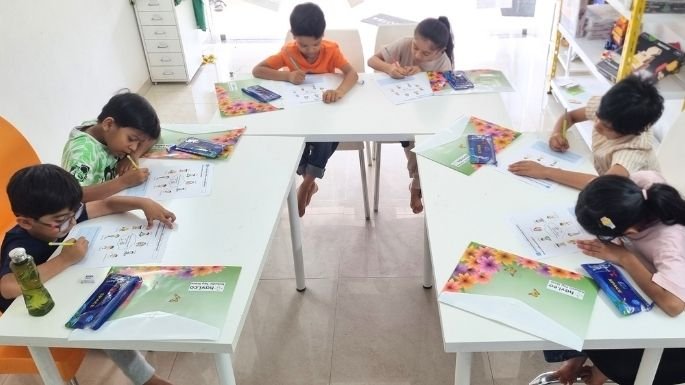
From the class experience – Teacher’s words
Day 1
And what a pleasant summer morning it was! It felt like our space had a rainbow. All the flowers had blossomed in colorful clothes, with matching accessories like watches, hair bands, rings—and what not! Who wouldn’t feel good with such cuteness overloaded?
I started by discussing activities they do at home. We understood the offline & online activities by examples.
Then, I handed over worksheets related to online vs. offline activity identification. We switched to Connect the Dots activities using arrow code. It seems fun, but most kids make mistakes. That’s where I come in — not to correct them, but to guide them toward figuring it out.
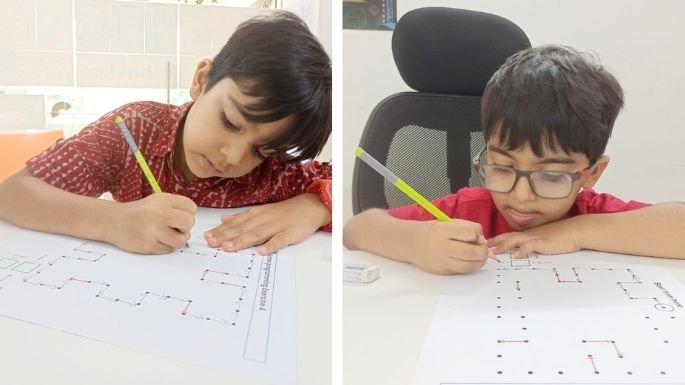
Introduce arrow codes and talk about how coding is a way to give instructions — to a computer or even to a friend.
That’s the end of the first day.
Day 2
We started our second day with some random conversations. Yes, younger kids have a lot to say! If they’re talking to you about their swimming class, last night’s dream, or their siblings — feel lucky. Not every teacher has that fortune! And I’am happy — I am very fortunate. Then we swiftly moved on to the ‘Connect the Dots’ activity, one more time. Revision is the key. You’ll see improvement in the results — kids will make fewer mistakes this time.
On the same day, we started the next chapter — maze puzzle coding. In our worksheets, we had designed two characters: Mitthu and Chikki. The task was to find the path between them using arrows and prepare the code.
Add a little more joy by giving them the freedom to trace the arrows with sketch pens. They love sketch pens, seriously!
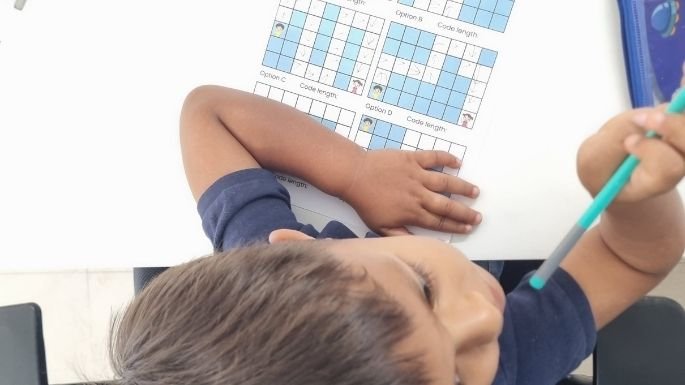
Wrapped up the day. My biggest achievement? Now I know their favorite color, too. 🙂
Day 3
Day 3 was easy for me, I repeated the maze puzzle codes with little twiks— and the kids gradually got better. This opened up discussions on finding shorter paths — which gently introduced them to network logic.
Day 4
It was the fourth day of the camp, halfway. I had started to recognize the pattern of every student now — when Zidaan would ask for water break, how Ritika would play with her specs when confused, or how Shrvil would start making lion sounds when idle…
This class was about storytelling. Happy, happier, happiest! Kids engage deeply with stories. Teaching debugging and related exercises became pretty easy through storytelling. They ended the day with debugging worksheets with the pinch of math & alphabetic touch.

Day 5
Then came the most hands-on activity — Paper Cup Programming.
Tables were ready with paper cup stacks.
“Look how Sharvil has created the castle. How? Because he knew how to do it? Because he is human? But what if we want to tell a robot to make this? What would the code be?” — and that goes on.
Initially, the paper-cup programming activity seemed very boring, what should I do now?, but then we started singing the code—like “up right right down left left”—to a tune. I sat with the kids to make the castles- one step at a time, and that’s how their interest grew.
Day 6
On the last day, we had robot roleplay. I placed Havi’s DIY Space Shuttle on a tile and had each child act like a robot — receiving commands to reach the spaceshuttle.
They laughed, thought, instructed each other, and understood how robots are coded.
I forgot to ask them to dress like robots — but you can do that.!
We wrapped up with a certificate ceremony. Parents and kids had one question: “What next?”
Rhea, in fact, wasn’t convinced it was really the last day. Can I ask more from the universe?
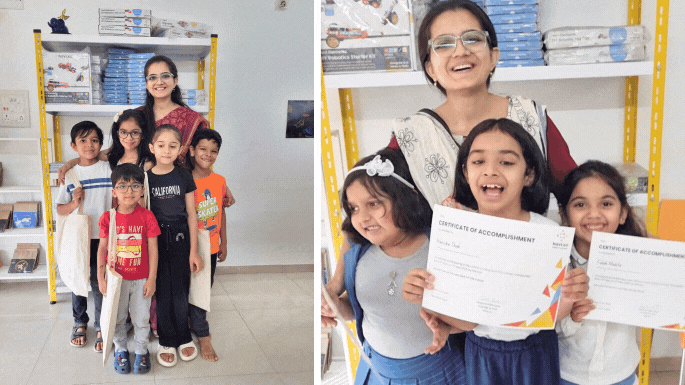
The response was overwhelming. We had so many inquiries that we had to launch a new batch!
So why keep it to ourselves?
We’ve now published a complete book on Offline Coding Activities. It’s a 54 page book, all colorful, kid friendly and easy to execute for teachers.
You can use this to teach screen-free coding at your home, school, preschool, or activity center. It’s also a great starter resource to introduce robotics and coding courses in schools. Contact us to get your copy!

